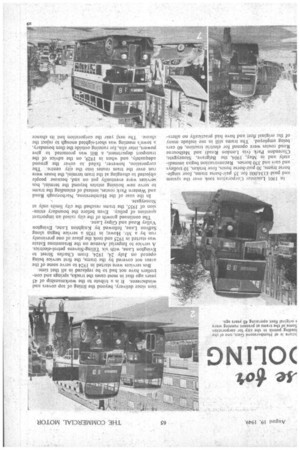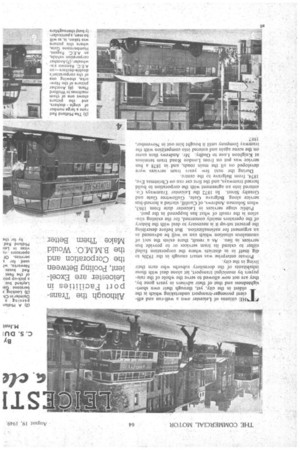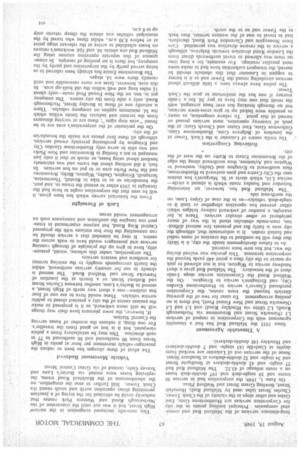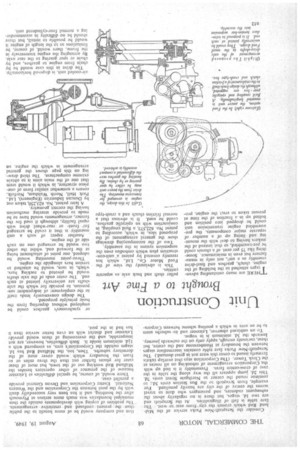4e 15-01 )OLIN
Page 43

Page 42

Page 44

Page 45

Page 46

If you've noticed an error in this article please click here to report it so we can fix it.
By C. S. DUI M.Inst rHE citizens of Leicester own a well-run and efficient passenger-transport undertaking which is the oldest in the city, yet, through their own shortsightedness and that of their advisers in years gone by, they are not now allowed to serve the whole of the ratepayers by municipal transport, let alone deal with those inhabitants of the dormitory suburbs who earn their
living in the city. .
Private enterprise was smart enough in the 19205 to dig itself in in districts where the corporation failed either to extend its tram services or to provide bus services in lieu. As a result, there exists the sort of anomalous situation which can so well be advanced as an argument for nationalization. But before describing the present set-up it is necessary to deal with the history of the operators mainly concerned, for the existing situation is the result of what has happened in the past.
Public stage services in Leicester date from 1863, when Soloman Andrews, of Cardiff, started a horsed-bus service along Belgrave Gate, Gallowtree Gate and Granby Street. In 1872 the Leicester Tramways Co. entered into an agreement with the corporation to build horsed tramways, and the first car ran on Christmas Eve, 1874, from Belgrave to the centre. .
During the next few years tram services were developed on all the main roads, and • in 1878 a bus service was put on from London Road tram terminus at Knighton Lane to Oadby. Mr. Andrews then came on the scene again and entered into competWon with the tramway 'Company until it bought him out in November, 1887
In 1901 Leicester Corporation took over the system and paid £134,000 for. 35 pair-horse trams, four singlehorse trams, 30 pair-horse buses, four brakes, 10 trolleys and cars and 370 horSes. Reconstruction began immediately and in May, 1904, the Belgrave, Stoneygate, Clarendon Park (via London Road) and Melbourne Road routes were opened for electric traction, 60 cars . being employed. The_ trams still in use include many of the original fleet and have hid practically no ahem
Lion since delivery, beyond the fitting of top covers and windscreens. It is a tribute to the Workmanship of 45 years ago that in most cases the trucks, springs and controllers have not had to be replaced in all that time.
Bus services were started in 1924 to serve some of the areas not covered by the trams, the first service being opened on July 24, 1924, from Charles Street to Evington Lane, with six Tilling-Stevens petrol-electrics, A service to Imperial Avenue on the Braunstone Estate was started in 1925 and took the place of one previously run by a Mr. Howe; in 1926 a service began along Saffron Lane, followed by Knighton Lane, Evington Valley Road and Gipsy Lane.
The continued growth of the city raised an important question of policy. Even before the boundary extension of 1935, the trams reached the city limits only at Stoneygate.
in the case of the Humberstone, Narborough Road and Western Park routes, instead of extending the trams to serve new hoUsing estates beyond the termini, bus services were eventually put on and, because people objected to changing at the tram termini, the buses were run over the tram routes into the city centre,The corporation, however, failed to cover the ground adequately, and when in 1929, on the advice of the transport department, a Bill was promoted to give powers, inter alia, for running outside the then boundary, a town's meeting was short-sighted enough to reject the clause. The next year the corporation lost its chance
of extending, for the Road Traffic Act, 1930, had the effect of stereotyping the allocation of services as at that date.
-With the extension of the boundary, the distances between the tram termini and the outskirts were in most cases increased still further, whilst the movement of population outwards reduced the number of shortdistance riders in the centre. As by that time extensic n and modernization of the tram system were considered to be unecono nic progressive abandonment was decided upon.
Outside the city private operation has been continuous since the horsed-bus era although, until the 1920s, many of the services worked only on market days. The Midland Red made its first appearance on the scene in 1919, with irregular services to Coalville and Coventry, but did not really get down to brass tacks until May 11, 1921. On that date a regular bus service was started to and from Nuneaton, followed on June 4 by one to and from Coventry.
Buses were not garaged a' Leicester until August 26, 1922. when the company ,opened a depot at Frog Island this v as replaced by one in Welford Road (also since closed) and the existing premises at Southgate Street and Sandacre Street were opened on July 21, 1927, and February 1, 1937, respectively The company aimed at putting on regular services either on roads which had not been served at all or on those Which had only market-day services into the city. Thus Blaby, Narborough, Wigston, Oadby and Syston were all connected up, as well as
Loughborough an d . places farther afield.
Fierce competition developed on most of these roads and the resultant chaos led to drastic action by the Leit-ester Watch Committee, which was then the licensing authority for the city.
In November, 1927, all opera tors were asked to submit timetables for the following year, and it was indicated that conditions would be attached to the licences which would be issued to cover them. Timetables stamped by the Public Carriage Department had to be exhibited in all buses and the exact route in and out of the city was laid down, as well as the exact route and destination outside. • Stands were allocated to each route and departure times at very close headways were enforced. At the end of 1927 the 102 licensed proprietors were running from 32 different stands, but a big improvement was effected on and from May 1, 1928. All buses serving places to the west and south-west were then concentrated at three points on the'Western Boulevard and those for the south in Newarke Street. To assist in enforcing the timetables, the authorities provided clocks, which had to be accepted as accurate. Most of the southern services were later ;transferred to another stand in the Newarke and, with more space available, it was possible, as a rtile, to arrange for buses, as soon as they were empty, to pull on to the stand in the order of departure.
This rule, which has since been general in Leicester, B10 enables passengers to sit in a bus awaiting departure time instead of standing on the pavement—a great improvement over the wretched arrangement which prevails in many districts of not allowing passengers on vehicles until a minute or two before they are due akvay.
In addition to the Western Boulevard and Newarke stands, other groups of routes were concentrated on Regent Street, All Saints' Road, Belgrave Gate and Humberstone Gate By 1931 the number of proprietors had fallen to 57, and to-day, in addition to the Corporation and the Midland Red, there are only 17 on stage-carriage work and 14 others on excursions.
The Miilland Red is the only private operator with which this article is really concerned, but for the information of students the others are as follows:— Barton Transport, Ltd. (to Nottingham); Trent Motor Traction Co., Ltd. (jointly with Midland Red to Loughborough via
Sileby): United Counties Omnibus Co., Ltd. (joint with Midland Red to Cosby); Lincolnshire Road Car Co., Ltd. (joint with Midland Red to Grantham); Mr, C. H. Allen, of Mountsorrel, working to Loughborough via Woodhouse Eaves and controlling Kemp and Shaw, Ltd. (serving Loughborough and Derby): Mr. Brown, of Markfield ; Mr. Gibson, serving Market Bosworth; MesSrs. W'indridge, Sons and Riley, of lbstock; Messrs. Hipwell and Preston (" of Woodhouse Eaves: Messrs. H. Boyer and Son, of Rothley, working to Loughborough: Messrs. Asti!! and Jordan, of Ratby ; Messrs. Hylton and Dawson, of Glenfield ;. Mr. Smith. of Groby; Mr. Parsons, of Stanton-under-Bardon : Mr. Bromley, of Fleckney ; Mr. Brown, of Sapeote, and Mr. Sweeton. running to Gumley and Lubbenham.
The Principal Loading Points The services previously terminating in All Saints' Road and Belgrave Gate are now worked from a bus station in Burley's Lane, near St. Margaret's Church, whilst the London Road services now terminate in Northampton Square. The Newarke and Newarke Street are still used for southbound services, and the latter is also a terminus for some of the City Transport buses.
The yard of Southgate Street garage" is used by a few
long-distance services of the Midland Red and associated companies Principal loading points in the city for Corporation services are Hutnberstone Gate, East Gates and other stops in the vicinity of the Clock Tower, Charles Street (also used by Midland Red), Horsefair -Street, Bowling Green Street and Welford Place.
On June 1, 1949, the corporation had in service 30 trams and 10 single-deck and 197 double-deck buses on a route mileage of 43.32. The Midland Red had 57 singleand 42 double-deckers at Southgate Street and 34 singleand 32 double-deckers at Sandacre Street. Some of the services out of Leicester are worked from depots at Coalville (43 singleand 7 double-deckers) and Hinckley (48 double-deckers).
A Timetable Agreement Since 1935 the Midland Red has had a timetable agreement with the Corporation in respect of services LI (Newarke Street and Braunstone via Narborough Road), L2 (ditto via Hinckley Road) and L3 and L4 (Newarke Street and New Found Pool), but there is no pooling arrangement. To cater for two of the growing districts beyond the tram routes, the Corporation purchased Cleaver's service to Humberstone garden City, and Errington's service to Evington. On the Welford Road the Corporation service stops 1-mile short of the boundary. The Midland Red gives a short headway service to Wigston, but is not allowed to pick up nearer to the city than-a point 440 yards beyond the corporation terminus. This proviso was waived during the war, but has now been restored.
As to future developments inside the city, it is likely that they will be confined to the creation of more radial and fantail routes. It is unfortunate that, although the city area is fairly flat and presents few natural difficulties, man-made obstacles stand in the way of many peripheral or other circular services. There is, for example, a number of awkward railway bridges which either prevent bus operation altogether or limit it to single-deck vehicles—as in the case of Gipsy Lane, on the north-east side.
The Midland Red has, however, an interesting Saturday and Sunday route which is almost a circleseryiee L16, which starts at St. Margaret's bus station near the City Centre and goes eastward to Hutnberstone, then southward to Evington and Oadby, westward to Wigston and Aylestone, then northward along the edge Of the Braunstone Estate to Ratby on the west of the city.
Relieving Congestion The traffic centre of Leicester is the Clock Tower at the junction of Belgrave Gate, Hurnberstone Gate, Gallowtree Gate, East Gates and Church Gate: at the peak of tramway operation, most services passed or turned at this point To relieve congestion, as many as possible were linked up to give cross-town services, but no through booking has ever been arranged, with the result that one may have to pay 3d. for, a 1-mile journey if one has the misfortune to pass the Clock Tower.
The police have always been a little difficult about services circulating round the Tower and as it is heresy to suggest in Leicester that this obstacle should be moved, the transport authorities have had to make some most peculiar ,routings. For example, for a long time no tram was allowed to travel northwards direct from the London Road direction towards Belgrave, although a service in the reverse direction was permitted. Cars from Stoneygate and Clarendon Park Road, therefore, had to travel to one of the western terthini, then back to the Tower and So to the north.
This naturally increased congestion in the narrovk :High Street, but it was not until the cOnversion of the ,Narborough Road and Western Park routes that authority could be obtained for the laying of a junction permitting direct operation north and southround the Clock Tower. Still further to ease the congestion, on the abandonment of the Blackbird Road trams, the replacing buses were routed via Burley's Lane and Sanvey Gate, instead of via Great Central Street
Vehicle Movement Reduced The effect of these changes has been to reduce the passenger-vehicle movement per hour at peaks in High Street from 90 westbound and 86 eastbound to 77 in each direction. This may be satisfactory from a police viewpoint, but it is hot so good from the traveller's. For one thing, it reduces the number of buses serving the Central Station.
If, however, the town planners have their way things will be still more awkward, as it is proposed to make the ancient centre of the city a precinct closed to public service vehicles. These would have to use one of four bus stations—one a short way north of High Street, a Second in Burley's Lane, another between Charles Street and Rutland Street, or a fourth at the junction of Newarke Street and Welford Road, The second is already in use for country services northward, whilst the fourth corresponds roughly to the existing termini for southern and western services The corporation, under this scheme, would, presumably, have to give up the principle of through tunning services and passengers would have to walk across the centre. It may be intended that a service should be run connecting the four bus stations with the proposed Central Ring Road, but anyone experienced in transport can imagine the confusion and annoyance such an arrangement would cause.
Lack of Foresight
From the historical survey which has been given, it will be seen that the corporation ought to have had the foresight in 1919 either to extend the trams to, and past, the boundaries so as to take in Birstall, Thurmaston, Scraptoft, Evington, Oadby, Wigston, Blaby, Braunstone and the New Parks area or to put on bus services. In fact, it did nothing about the trams and was extremely hesitant about using buses, so much so that it only just managed to get a footing in Braunstbne and New.Parks and was able to serve only Humberstone Garden City and Evington by purchasing privately owned services, although all these four places are inside the boundaries of the city.
On the perimeter of the corporation's area are to be found "area stop signs "; these are at varying distances from the termini and indicate the limits within which the 3d. minimum applies on company vehicles. There is actually one of these in Barclay Street, Narborough Road, only a mite from the city centre. The company got in, too, on the New Found Pool route--only. about miles long and well within the old built-up area. In this case, however, fares are more reasonable-and until recently there were Id. stages.
The Braunstone Estate has already been referred to as being served partLy by the corporation and partly by the company, but there is no pooling of receipts. In consequence of this separate operation anyone using the Midland Red can obtain 3d. ancflid. workmen's returns on buses scheduled to arrive at the relevant stage point at or before 8.30 a.m., whilst those who travel by the municipal vehicles can obtain the cheap returns only up to-8 a.m. Consider the Scraptoft-New Parks service of the Midland Red which crosses the city from east' towest. The
fare table is full of illogicalities. At the Scraptoft end are two Id. stages, but there is no regularity about the subsequent cadences, and passengers who dare to travel across the centre of the city are heavily penalized. For example, from Scraptoft to the Bus Station costs 5d.; to continue round the corner to Northgate Street costs 7d. This 2d. jump appears all the way along the table in the case of cross-centre fares. Presumably it is tied up with the, Corporation arrangement of rebooking on all routes at the Clock Tower. (The Corporation says that overlap tickets formerly,issued to cover this were not in great demand.) The Scraptoft-New Parks fare table contains intermediate stages between the boundary at Httmberstone and the centre, but these, curiously enough, apply only on the outwards journey. inwards the 3d. minimum is in vogue.
To an unbiased observer, Leicester and itssuburbs seem to be an area in which a pooling scheme between Corpora
lion and company would be of more benefit to the public than the present -confused and restrictive arrangements. 1 he problem of coping with developments outside the then municipal boundaries was much more serious at Plymouth after the bombing, and it has been very successfully dealt with by the pool between the Corporation and the Western National. Exeter Corporation and Devon General provide
a parallel case. • There would, of course, be special difficulties at Leicester because of the presence of other operators besides the Midland Red working out of the town, but most of these cater for places farther out than the three miles or so from the boundary which would cover most of the dormitory suburbs. Then, too, the Midland Red has Id. stages outside the Corporation's area, as compared with a lid. minimum inside it. Such difficulties, however, are not insuperable, and the overcoming of them would provide I.eicester and district with an even better service than it has had in the past.




















































































